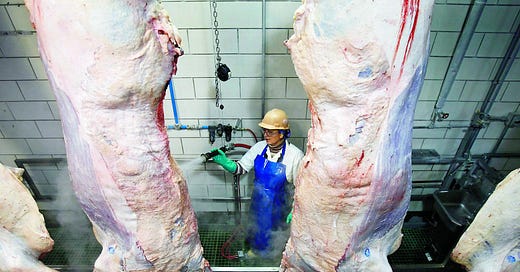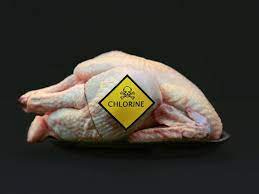Are you a regular meat eater? Assuming if you subscribe to this newsletter the answer is yes. After a recent discussion with Josh Rainer Gold on my podcast, Decentralized Radio, I learned about the chemical washing process required by the USDA for all meat processors. This is a requirement for all meat for anti-microbial purposes, and the type of chemical/wash used varies by the type of meat and the quality of the processor. If your producer wants to sell their meat across state lines, they have to go to a USDA inspected facility, that is the law. For that reason, USDA is strict on these type of washes because the meat likely will travel long distances and experience various temperature changes-common ways to get dangerous bacteria on meat. These are known as Pathogen Reduction Treatments (PRTs). However, the chemical washes that most processors use are DISTURBING to say the least.
Let’s start with every gym bros favorite protein…CHICKEN. 95+% of chickens processed in a USDA facility use CHLORINE as their anti-microbial chemical wash. Yes, you read that correctly. Tyson is dunked in chlorine before it gets cut up and thrown in the supermarket for an inconceivably low price point. When chickens are slaughtered and defeathered, they are always put in an ice bath to reduce risk of spoiling by cooling down the carcass. If you process hundreds or thousands of chickens like Tyson, they all get thrown in the same bath, so inherently the risk of contamination rises tremendously. Adding chlorine to this bath is an easy way to kill pathogens for a lot of chickens simultaneously. A wash that works at scale, a USDA favorite. Chlorine bathed chickens are completely safe for consumption.
Just how much chlorine is in the meat that you would be consuming? During US-UK trade talks a study was published reviewing findings to persuade the public that PRTs are no big deal. I disagree, but they had some nice data to cite.
“The British government limits the combined concentration of chlorite and chlorate in water at 0.5mg per litre.15 At that upper bound, eating a whole chicken is roughly equivalent to drinking a glass of water.”
I don’t know about you, but the reason I don’t drink tap water is because of toxins like chlorine being extremely prevalent…and the only thing a Brita is good for is filtering out Chlorine. But hey, to each their own…that is also why I almost never go in a chlorinated swimming pool either but the point here is 99% of people HAVE NO IDEA that almost ALL chicken in the US is dunked in a chlorine bath during processing. The EU banned the import of chicken disinfected with chemical rinses for two decades, I like that style. Also, if you raise a chicken properly and don’t need to ship it across the world…you have a much less worry about pathogens.
What about BEEF? Beef and other ruminant processing is also subject to the same PRT requirement and just like chicken. The most common PRT treatments that I am aware of are citric acid and lactic acid. These are also two of the MOST COMMON additives you see in food across the board (for the same reason). They improve shelf stability, ward off pathogens, and inhibit lipid oxidation. Citric acid and Lactic Acid are naturally occurring compounds, so it should not be an issue at all for them to be used in our meat processing right? RIGHT, but also wrong. Citric acid is naturally occurring, however the citric acid used as a food additive is not naturally occurring but rather derived from BLACK MOLD. Yes, again, you read that correctly. “Modified” citric acid (MCA) is derived from Aspergillus niger, a black mold that is a known allergen. The MCA is allowed to be labeled as just “citric acid” with no indication to consumers on its origin. Approximately 99% of the world’s production of MCA is carried out using this fungus. The FDA placed MCA under the category of “generally recognized as safe” without any research to substantiate this claim. MCA is also predominantly produced in China. Next time you see citric acid on a label, think twice.
Lactic acid is another naturally occurring compound that can be derived from fermentation methods or derived synthetically. The synthetic derivation is made through the chemical addition of hydrogen cyanide to acetaldehyde (from coal or crude oil) and subsequent hydrolysis of lactonitrile with hydrochloric acid and ammonium chloride. I did reach out to a common meat processing supply website and asked about the source of their lactic acid carcass wash-thankfully it was positive. The spec sheet they sent said their Lactic Acid was produced by fermentation from sugar, and is certified kosher and suitable for use in organic products. HERE is the link to that lactic acid if you want to check it out yourself.
This why it is important to know the source of your meat and have a good relationship with BOTH your local rancher and meat processor. You really can not know unless you ask, and if it is a USDA plant you can be sure they are most likely using citric or lactic acid PRT. It seems like the lactic acid is far more likely to come from a naturally derived source, but you can know for sure until you ask. You can also be happy to let them know your feedback, but be mindful that you should always do this respectfully because many processors just follow USDA recommendations. I did the due diligence and asked my local meat processor who processes our bison and also a lot of the other local meat I buy (lamb), and he said they use an organic peroxide PRT wash. I asked about citric and lactic acid and he straight up said “Tristan that stuff makes the meat taste not as good. I am happy to be transparent with you, the stuff we buy is definitely more expensive but we think it results in a better end product.” I looked up the organic peroxide wash and it certainly had better ingredients that made up the majority of the wash (hydrogen peroxide + acetic acid) but there was a very small amount of diphosphonic acid (HEDP) in the wash as well <120ppm that I am not a fan of. I may push harder on investigating this, or looking into even more natural alternatives that our processor may be open to.
This is why buying local is even more powerful than you realize, because when you bring your meat to a state run facility (not overseen by the USDA), they do not even have to worry about carcass washes and chlorine baths. You get a lot more freedom and less chemicals when you are only selling meat in state. I brought my elk to a small state run facility last year and I can say that I was extremely happy with the result and trust eating it raw in elk tartare fashion occasionally. The ultimate goal would be to process any wild game I harvest myself (I did my antelope last year-very time consuming but worth it) and then find a very high quality and transparent processor for beef/bison/lamb/etc. State run facilities are a dime a dozen, and have their own fair share of issues, but if it is something in your area I highly recommend you utilize them before there are none left. There are also farms/ranches that do subscription memberships and process all the meat they raise themselves, this is one way of getting OUT of the USDA oversight (to some degree), and not being at the whim of a processing plant’s availability + customer service. Processors are the main bottle neck of the livestock industry, without them you have no product, but with all the rules and regulations influenced by the big meat packers coming down from the USDA…it is getting harder and harder for the small producer to have a say. That is resulting in lower quality meat across the board for our country.
Knowledge is power, but relationships are even more impactful. Make connections in your local community to understand the ins/outs of your area’s livestock production.
IF you are interested in some 100% Grass Fed Bison Meat that is not NOT sprayed with citric acid carcass wash (and is unvaxxed), check out Falls Family Ranches, the bison ranch I sell/market for in beautiful Central Wyoming. Use TRISTAN10 for 10% off your first order.
Stay Sovereign,
Tristan






Thanks Tristan. I didn't know about these washes -- and I'll not eat chicken again from a package.